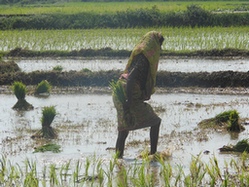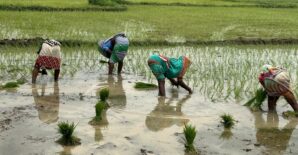It is widely believed that increased usage of new technologies directly affects the advances in agricultural development. The uptake and use of new technologies is highly dependent on several context-specific factors. Among other important factors, farmers’ perceptions of risks associated with the new technology as well as their ability or willingness to take risks greatly influences their adoption decisions. Farmers in developing countries face a wide range of uncertainty, not the least of which arises from climate variability, including droughts, which represent one of the most pressing constraints to rice production in unfavorable environments.
Despite the heralded benefits of new agricultural technologies such as drought tolerant cultivars (DT), widespread adoption of new technologies is often a slow process. Some factors that influence adoption decisions may not be directly visible, such as farmer preferences regarding uncertainty. When it comes to new technologies, uncertainty arises due to both risk as well as ambiguity. Risk arises because, while almost all new agricultural technologies tout increases in mean productivity, many perform optimally only under certain conditions. Deviations from these conditions may result in not only reduced yield benefits vis-´a-vis the traditional technology but also increased variance. Ambiguity, on the other hand, arises because new technologies are unknown and unproven in the minds of prospective adopters, who generally do not know the yield distribution of the new technology. Combined, aversion to both risk and ambiguity may lead to production decisions that are incongruent with deterministic profit maximization.
In a recent IFPRI Discussion Paper, Risk and Ambiguity Preferences and the Adoption of New Agricultural Technologies authors Patrick Ward and Vartika Singh analyze various behavioral parameters related to risk and ambiguity aversion collected through field experiments in rural India. The experimental design allows for the identification of several different parameters, accomplished over a series of five experiments, each comprising a set of choices between two options with different real payouts. Specifically, the authors find that risk aversion alone does not sufficiently describe individuals’ behavior, but rather they also find that individuals have a tendency to weigh outcomes differently and demonstrate aversion to potential losses. Using gender-disaggregated experimental data, the authors demonstrate that women are both significantly more risk averse and loss averse than men. Contrary to some previous findings in different contexts, Ward and Singh find no significant evidence of ambiguity aversion.
Coupling these behavioral parameters with a discrete choice experiment designed to study preferences for (DT) rice, they observe that farmers’ risk and loss aversion interact with their perceptions about the potential risks and losses associated with the new seeds. They observe that both risk aversion and loss aversion significantly increase the probability that farmers will choose the newer seeds: Farmers were more likely to experiment with new seeds that provided some form of yield benefit, whether it was a reduction in variability or protection against low-probability, high-impact extreme droughts. The role of risk and ambiguity preferences seems straightforward when it comes to a technology like DT rice, since the technology yields benefits specifically targeted to farmers with value functions, sensitive risks and potential losses. Considerable scope remains to explore the role of risk and ambiguity preferences on other agricultural technologies, especially ones in which the technology is less embodied in the physical product.
Related Material
- Farmer Preferences for Drought Tolerance in Hybrid versus Inbred Rice
- The Economics of Hybrid Rice in South Asia
- Patrick Ward’s Op-Ed in The Financial Express
- Presentation: Are farmers in India willing to pay for drought tolerant rice?



